- CORD(S)
- 1) A length of decorative string or rope made from several twisted strands
with tassels at each end, generally made of silk (or a silk-like material) in
the livery or national colours (or gold/silver thread), simply knotted or tied
a bow at the centre and used to decorate a staff (usually) just below the finial –
especially (but not exclusively) that of a parade flag or military colour
‘aiguillette’,
(see also ‘colour 2)’,
‘cravat 1)’,
‘finial’,
‘lanyard 1)’,
‘livery colours’,
‘national colours 2)’,
‘parade flag 2)’,
‘staff 2)’ and
‘tassels’).
- 2) As above but without tassels and used to finish the edges of a flag, usually
in the livery or national colours (or gold/silver thread).

Ceremonial Flag of Abedim-Moncao, Portugal (fisisco)
-
- CORDED CROSS
- See ‘roped cross’.

(Seiyaku.com)
- CORDS AND TASSELS
- See ‘cord(s) 1)’ and ‘tassels’.
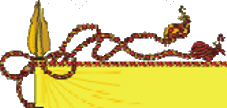
Ceremonial Flag of Abedim-Moncao (detail), Portugal (fisisco)
- CORE FLAG
- The flag whose design forms the basis of other flags, or which inspired
the creation of other flags, with a typical two examples being the Arab revolt
flag of 1917 and the French tricolore (see
also ‘archivexillum’,
‘difference 1)’
‘flag family’, 'pan-African Colours',
'pan-Arab Colours' and 'pan-Slavic Colours').
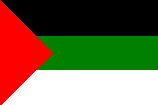
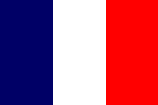
Arab Revolt Flag 1917 and French Tricolore (fotw)
- CORNET (or CORNETTE or CORNUTE)
- 1) In largely British maritime usage a term, now increasingly obsolete, for
a small triangular pennant (see also 'pennant 2)').
- 2) In British RN and some other usage a term, now almost wholly obsolete,
for a swallow-tailed flag, particularly (but not exclusively) a signal flag (see also
‘signal flag’
and ‘swallow-tail(ed)’).
- 3) A 17th/18th Century generic term, now obsolete, referring to any small,
swallow-tailed flag.
- 4) An alternative form of ‘guidon’, now obsolete, as being the distinguishing
flag of a cavalry regiment (see also ‘guidon 2)’).
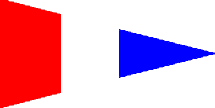

“Preceding Under Steam and Sail” in The Commercial Code of Signals c1860 (CS);
Cornette/Pennant of a Senior Officer/Commodore, Austria then Austria-Hungary 1786 – 1894 (fame)
- 5) A term, now obsolete, for lowest commissioned rank in the cavalry regiments
of some countries (including those of the UK), being that rank responsible for
carrying the regiment’s cornet or guidon.
- CORNSHEAF
- See ‘garbe’.

Flag of Reduzum, The Netherlands (fotw)
- CORNUCOPIA
- An ancient symbol of prosperity and now generally shown as a hollow, horn-shaped
basket usually (but not invariably) filled to overflowing with various kinds of festive
fruit and/ or vegetables etc – a horn of plenty.





Arms and Flag of Kharkiv, Ukraine (fotw); National Arms of
Honduras (fotw); Flag and Arms of
Ivankovo, Croatia (fotw)
- CORONATION FLAGS (or CORONATION BANNERS)
- A term for those flags or banners (differing from the usual royal standard) which are prepared
specifically for display at the installation (coronation, swearing-in or simple inauguration) of a
monarch and often (but not exclusively) consisting of the relevant royal or
national arms on a plain field – a “rijksvaandel”,
“riksbanner”, “royal
banner” or “banner of the realm” (see also ‘greater arms’
under ‘arms’, ‘installation flags’ and
‘royal standard(s) 1)’).
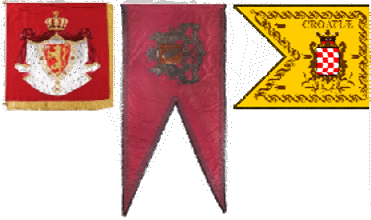
Coronation Flags (riksbanner), Norway 1906 and 1818 (official website);
Flag of Croatia for the Coronation of Ferdinand V in Bratislava 1830 (fotw)
- CORONET
- 1) Generically on flags, a crown without a curved bar across the top that
may be seen in a wide variety of shapes and circumstances - an open crown
(see also ‘antique crown’,
'civic crown',
‘crown’,
'mural crown' and
'naval crown' and
‘provincial crown’).
- 2) Specifically on flags, the term may be used when a hereditary ruler (or
former hereditary ruler) is of a
lesser rank than that of crowned monarch - a princely, arch-ducal or
grand-ducal coronet (bonnet
or hat), or similar (see also ‘electoral cap’).
- 3) In English heraldry a crown without cross bar across the top as 1) above,
but also a symbol of nobility whose exact design is dependent upon the rank of
the person concerned (see also ‘mantle’).
![[coronet]](../images/v/vxt-d906.gif)
![[coronet]](../images/v/vxt-d906a.gif)
![[coronet]](../images/v/vxt-d906b.gif)
Archducal Coronet, Austria (fotw); Coronets of an Earl and of a Viscount in English heraldry (Wikipedia)
Please note that the use of a cross-bar across the
top to indicate royal status and to differentiate between a crown and a coronet
is of comparatively recent date.
- CORPORATE FLAG
- The distinguishing flag of a shore based commercial concern as opposed to
that of merchant marine company (see also
‘house flag 1)’ and
‘logo’).
![[Corporate flag]](../images/v/vxt-d582.gif)
![[Corporate flag]](../images/v/vxt-d1918.gif)
![[Corporate flag]](../images/v/vxt-d1919.gif)
Corporate Flag of Lufthansa, Germany (fotw); Corporate Flag of
Citroën, France (fotw); Corporate Flag of
Banco Totta, Portugal (fotw)
- CORPORATION (or CORPORATE) BANNER
- In largely UK usage, a type of processional banner whose symbolism relates to the
corporate body of a town council or corporation, or to the community represented –
see ‘banner 3)’.
- CORPS FLAG
- 1) See ‘camp flag’.
- 2) See ‘branch of service flag 2)’.
![[Corps flag]](../images/v/vxt-d1444.gif)
![[Corps flag]](../images/v/vxt-d1445.gif)
Corps/Camp Flag of the Royal Armoured Corps, UK (Graham Bartram); Flag of the
Corps of Engineers, US (fotw)
- CORSAIR
- See ‘privateer(s)’.
- CORSAIR ENSIGN
- See ‘privateer ensign’
and ‘jolly roger 1)’.
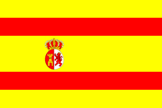
Corsair/Privateer Ensign, Spain 1820 (fotw)
- COTTICE (COTISE or COST)
- See ‘appendix VII’ (also
‘cotticed 1)’ below).
![[example]](../images/v/vxt-d1164a.gif)
- COTTICED (COTISED or COTIZED)
- 1) On flags, a term that may be used to describe the addition of one or more
narrow stripes or bands to an existing charge (such as a stripe or cross) but
which is separated from that charge by a strip of field - but see note below.
- 2) In heraldry the term has a rather more restricted/complex use which is
briefly described in Appendix VII, however, it is
suggested that a suitable glossary or dictionary of heraldry should be
consulted for further details.


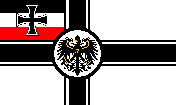

Flag of Bělá u Jevíčka, Czech Republic (fotw);
Naval Ensign of Ukraine (fotw); Imperial War Flag 1903 – 1919, Germany (fotw); Flag of Koblenzer Rowing club, Germany (fotw)
Please note with regard to 1) that where the field is not shown between the charge
and the cottice (as illustrated below) it should be described as double or triple fimbriated as appropriate
(see also ‘fimbriation 1)’).
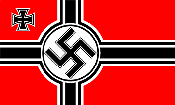

War Ensign of Germany 1938 – 1945 (fotw); Pennant of the
Allgemeiner Deutscher Automobilclub, Germany (fotw)
- COUCHANT
- See ‘Appendix V’.

Arms of Tristach,
Austria (ICH)
- COUNTER-
- The heraldic prefix used when two charges on a shield, banner of arms or flag are turned in contrary directions
as in “fleuri-counterfleuri” (see ‘double-tressure’), or when two
tinctures are reversed either side of a line or lines drawn through a coat of arms see
‘counterchanged’ (also
‘counterchanged cross’ in ‘appendix VIII’ and
‘counter-compony’).
- COUNTER-COMPONY
- An abbreviation of the heraldic term compony counter-compony used when an
ordinary or border is composed of two rows of squares (or occasionally
rectangles) in alternating tinctures – see ‘counter-’ above and
‘compony’
(also ‘checky 1)’,
‘checky 2)’,
‘counterchanged’ below,
‘ordinary’ and
‘tincture’).
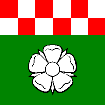


Flag of Olsberg, Switzerland (fotw): Flag of Niemcza, Poland (Jarig
Bakker): Flag of Calfreisen, Switzerland (fotw)
- COUNTERCHANGED (or COUNTER-CHANGED)
- (adj) A basically heraldic term used to describe two colours alternating either
side of a line or lines drawn through a flag or coat of arms or charge - parti-coloured
(see also ‘charge’,
‘coat of arms 2)’
‘counter-’,
’counterchanged cross’ in ‘appendix VIII’,
‘counter-compony’ above
and ‘faceted’).
![[counterchanged]](../images/v/vxt-d101.gif)
![[Greenland]](../images/v/vxt-d101a.gif)
![[Tas-Sliema, Malta]](../images/v/vxt-d1963.gif)
![[Supetar, Croatia]](../images/v/vxt-d2178a.gif)
![[Supetar, Croatia]](../images/v/vxt-d2178.gif)
![[Maryland, US]](../images/v/vxt-d101b.gif)
From left: counterchanged example; Flag of Greenland (CS); Flag of
Tas-Sliema, Malta (fotw); Arms and Flag of
Supetar, Croatia (Željko Heimer); Flag of
Maryland, USA (CS)
- COUNTERCHANGED CROSS
- See ‘cross counterchanged’ in
‘Appendix VIII’.

Putative Banner of the Dominicans (fotw)
- COUNTY ARMS (or COAT OF ARMS)
- See ‘civic arms 2)’.
![[Gloucestershire county arms]](../images/v/vxt-d304.gif)
Arms of the County of Gloucestershire, UK (ICH)
- COUNTY FLAG
- See ‘sub-national flag’ (also
‘civic flag 2)’.
![[Gloucestershire county flag]](../images/v/vxt-d306.gif)
Flag of the County of Gloucestershire, UK (fotw)
- COUPEAU (or COUPEAUX)
- A French heraldic term for the base of a shield, banner of arms or a flag that is composed of
semi-circular mounds, and is intended to represent (usually) three (but up to six) hills –
a coupeau of three, four, five or six, mount of coupeau or threemount -
see ‘compartment’ (also ‘mount’).

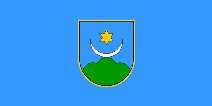


Arms and Flag of Ludbreg, Croatia (fotw); Arms of Pope Paul VI (Modern Popes); Flag of Oberohrdorf, Switzerland (fotw)
- COUPEAU (or COUPEAUX) OF THREE (or COUPEAU/COUPEAUX OF FOUR, FIVE
or SIX)
- See ‘coupeau’ above.




Flag of Kirchberg, Switzerland (fotw); Flag of
Villarbeney, Switzerland (fotw); Flag of Obstalden, Switzerland (fotw); Flag of Delémont, Switzerland (fotw)
- COUPED
- 1) The heraldic term used when a charge is cut off in a straight line as is often the case with the heads and
limbs of animals but see 2) below (also 'erased').
- 2) A heraldic term that is also used when an ordinary or charge does not extend to
the edges of a shield or banner of arms, for example a cross-couped – but see
‘slipped’ (also
‘charge’,
‘cross-couped’ in ‘appendix VIII’,
‘Greek cross’ and
‘ordinary’).
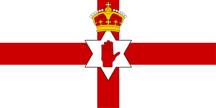


Unofficial Flag of Northern Ireland (fotw); Flag of
Andwil, Switzerland (fotw); National Flag of
Tonga (fotw)
- COURTESY FLAG
- That flag (normally, but not exclusively, the national flag of the country
being visited) flown from a prominent position on a merchant vessel as a matter
of courtesy when visiting a foreign port – a complimentary flag (see also
‘yardarm’).
- COVERING
- In vexillology the term used when a canton charge or emblem obscures the entire width of a stripe or stripes on a multi-striped flag,
and in the case of a canton usually (but not invariably) at the hoist – for example, a square or rectangular canton covering the first
three stripes or a charge off-set towards the hoist and covering the centre
five stripes as shown below - encroaching upon (see also
‘canton 2)’,
‘multi-stripe’ and
‘overall 1)’ and
‘partially covering’).
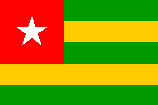


National Flag of Togo (fotw); Flag of
Goiás, Brazil (fotw); Flag of
The Bohus Line, Sweden (Eugene Ipavec)
Please note that this term is never used alone but always with the number of
stripes being covered.
- COWARD
- See ‘appendix V’.
![[coward]](../images/v/vxt-d1109.gif)
![[coward]](../images/v/vxt-d1109a.gif)
Flag and Arms of Paršovice, Czech Republic (fotw)
- COWED
- See ‘queued’.










![[coronet]](../images/v/vxt-d906.gif)
![[coronet]](../images/v/vxt-d906a.gif)
![[coronet]](../images/v/vxt-d906b.gif)
![[Corporate flag]](../images/v/vxt-d582.gif)
![[Corporate flag]](../images/v/vxt-d1918.gif)
![[Corporate flag]](../images/v/vxt-d1919.gif)
![[Corps flag]](../images/v/vxt-d1444.gif)
![[Corps flag]](../images/v/vxt-d1445.gif)











![[counterchanged]](../images/v/vxt-d101.gif)
![[Greenland]](../images/v/vxt-d101a.gif)
![[Tas-Sliema, Malta]](../images/v/vxt-d1963.gif)
![[Supetar, Croatia]](../images/v/vxt-d2178a.gif)
![[Supetar, Croatia]](../images/v/vxt-d2178.gif)
![[Maryland, US]](../images/v/vxt-d101b.gif)

![[Gloucestershire county arms]](../images/v/vxt-d304.gif)
![[Gloucestershire county flag]](../images/v/vxt-d306.gif)














![[coward]](../images/v/vxt-d1109.gif)
![[coward]](../images/v/vxt-d1109a.gif)





![[example]](../images/v/vxt-d1164a.gif)